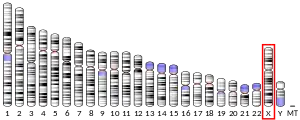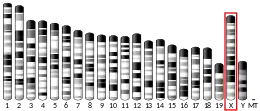ADP/ATP translocase 2 is a protein that in humans is encoded by the SLC25A5 gene on the X chromosome.[5]
This protein functions as an antiporter for ADP/ATP exchange between the mitochondrial matrix and cytoplasm.[5][6][7] As a result, it plays a key role in maintaining mitochondrial membrane potential and inhibiting apoptosis and has been targeted for treating cancer.[5][6]
Structure
The SLC25A5 gene belongs to the ANT gene family, which itself belongs to the superfamily that includes genes encoding brown fat mitochondrial uncoupling proteins and mitochondrial phosphate carrier proteins. Compared to the other gene isoforms, SLC25A5 possesses different motifs, including a CCACT sequence rather than the canonical CCAAT sequence upstream of the TATA box, as well as five SP1 binding sites.[8] This gene consists of 4 exons, while its encoded protein forms a homodimer embedded in the inner mitochondrial membrane.[5][6] The entire protein is composed of 300-320 amino acid residues folded into six transmembrane helices.[6][9] The human genome contains four differentially expressed isoforms, as well as several non-transcribed pseudogenes, of this gene.[5][10][11]
Function
This gene is a member of the mitochondrial carrier subfamily of solute carrier protein genes. The product of this gene, adenine nucleotide translocator 2 (ANT2), functions as a major constituent of the mitochondrial permeability-transition pore complex that catalyzes the exchange of mitochondrial ATP with cytosolic ADP.[5][9][12] As a result of its antiporter function, ANT2 maintains mitochondrial membrane potential by regulating ADP/ATP ratios in oxidative phosphorylation. ANT2 facilitates uncoupling of the mitochondrial membrane when acylated by SIRT4.[6][7] Though uncoupling the membrane potential typically leads to apoptosis, ANT2 was found to be antiapoptotic. As a result, it is postulated to mediate the TFIIH-dependent response to DNA damage as a component of the MMS19-XPD.[12] Alternatively, suppressing the expression of this gene has been shown to induce apoptosis and inhibit tumor growth.[5][6]
Though ANT2 is highly conserved and ubiquitously expressed, its expression levels and, accordingly, biological function, may vary depending on tissue type.[7][9][11] It is specifically expressed in undifferentiated cells and renewable tissues while maintaining low expression levels in differentiated cells. Due to its expression profile, it has been used as a growth marker and targeted for studies in tumor cell growth.[6][11]
Clinical Significance
The SLC25A5 enzyme is an important constituent in apoptotic signaling and oxidative stress, most notably as part of the mitochondrial death pathway and cardiac myocyte apoptosis signaling.[13] Programmed cell death is a distinct genetic and biochemical pathway essential to metazoans. An intact death pathway is required for successful embryonic development and the maintenance of normal tissue homeostasis. Apoptosis has proven to be tightly interwoven with other essential cell pathways. The identification of critical control points in the cell death pathway has yielded fundamental insights for basic biology, as well as provided rational targets for new therapeutics a normal embryologic processes, or during cell injury (such as ischemia-reperfusion injury during heart attacks and strokes) or during developments and processes in cancer, an apoptotic cell undergoes structural changes including cell shrinkage, plasma membrane blebbing, nuclear condensation, and fragmentation of the DNA and nucleus. This is followed by fragmentation into apoptotic bodies that are quickly removed by phagocytes, thereby preventing an inflammatory response.[14] It is a mode of cell death defined by characteristic morphological, biochemical and molecular changes. It was first described as a "shrinkage necrosis", and then this term was replaced by apoptosis to emphasize its role opposite mitosis in tissue kinetics. In later stages of apoptosis the entire cell becomes fragmented, forming a number of plasma membrane-bounded apoptotic bodies which contain nuclear and or cytoplasmic elements. The ultrastructural appearance of necrosis is quite different, the main features being mitochondrial swelling, plasma membrane breakdown and cellular disintegration. Apoptosis occurs in many physiological and pathological processes. It plays an important role during embryonal development as programmed cell death and accompanies a variety of normal involutional processes in which it serves as a mechanism to remove "unwanted" cells.
The SLC25A5 gene is important for the coding of the most abundant mitochondrial protein Ancp which represents 10% of the proteins of the inner membrane of bovine heart mitochondria.[15][16] Ancp is encoded by four different genes: SLC25A4 (also known as ANC1 or ANT1), SLC25A5 (ANC3 or ANT2), SLC25A6 (ANC2 or ANT3) and SLC25A31 (ANC4 or ANT4). Their expression is tissue specific and highly regulated and adapted to particular cellular energetic demand. Indeed, human ANC expression patterns depend on the tissue and cell types, the developmental stage and the status of cell proliferation. Furthermore, expression of the genes is modulated by different transcriptional elements in the promoter regions. Therefore, Ancp emerges as a logical candidate to regulate the cellular dependence on oxidative energy metabolism.[15]
Overexpression of ANT2 has been linked to tumor cell growth and attributed to its anti-apoptotic function. One study found that specific silencing of the ANT2 gene failed to induce apoptosis to tumor cells without a combining treatment with lonidamine, an anti-tumor drug, thus indicating that additional factors may be involved to mediate membrane permeability and programmed cell death.[6][10] According to a study by Oishi et al., knockdown of ANT2 upregulated DR5, resulting in Apo2L/TRAIL-induced apoptosis.[10] Moreover, studies by Ji-Young Jang et al. confirmed the effectiveness of silencing ANT2 in breast cancer and hepatocellular carcinoma using small hairpin RNAs (shRNA).[11][17] Thus, ANT2 inhibitors could contribute to anticancer therapies.[10][11]
In the brain, ANT2 participates as part of the post-synaptic density (PSD) and, thus, has been associated with X-linked intellectual disability (XLID).[9]
Interactions
SLC25A5 has been shown to interact with:
References
- 1 2 3 GRCh38: Ensembl release 89: ENSG00000005022 - Ensembl, May 2017
- 1 2 3 GRCm38: Ensembl release 89: ENSMUSG00000016319 - Ensembl, May 2017
- ↑ "Human PubMed Reference:". National Center for Biotechnology Information, U.S. National Library of Medicine.
- ↑ "Mouse PubMed Reference:". National Center for Biotechnology Information, U.S. National Library of Medicine.
- 1 2 3 4 5 6 7 "Entrez Gene: Solute carrier family 25 (mitochondrial carrier; adenine nucleotide translocator), member 5". Retrieved 2013-09-18.
- 1 2 3 4 5 6 7 8 Chevrollier A, Loiseau D, Reynier P, Stepien G (Jun 2011). "Adenine nucleotide translocase 2 is a key mitochondrial protein in cancer metabolism". Biochimica et Biophysica Acta (BBA) - Bioenergetics. 1807 (6): 562–7. doi:10.1016/j.bbabio.2010.10.008. PMID 20950584.
- 1 2 3 4 Ho L, Titus AS, Banerjee KK, George S, Lin W, Deota S, Saha AK, Nakamura K, Gut P, Verdin E, Kolthur-Seetharam U (Nov 2013). "SIRT4 regulates ATP homeostasis and mediates a retrograde signaling via AMPK". Aging. 5 (11): 835–49. doi:10.18632/aging.100616. PMC 3868726. PMID 24296486.
- ↑ Ku DH, Kagan J, Chen ST, Chang CD, Baserga R, Wurzel J (Sep 1990). "The human fibroblast adenine nucleotide translocator gene. Molecular cloning and sequence". The Journal of Biological Chemistry. 265 (27): 16060–3. doi:10.1016/S0021-9258(17)46187-4. PMID 2168878.
- 1 2 3 4 Vandewalle J, Bauters M, Van Esch H, Belet S, Verbeeck J, Fieremans N, Holvoet M, Vento J, Spreiz A, Kotzot D, Haberlandt E, Rosenfeld J, Andrieux J, Delobel B, Dehouck MB, Devriendt K, Fryns JP, Marynen P, Goldstein A, Froyen G (Oct 2013). "The mitochondrial solute carrier SLC25A5 at Xq24 is a novel candidate gene for non-syndromic intellectual disability". Human Genetics. 132 (10): 1177–85. doi:10.1007/s00439-013-1322-3. PMID 23783460. S2CID 18376440.
- 1 2 3 4 Oishi M, Iizumi Y, Taniguchi T, Goi W, Miki T, Sakai T (2013). "Apigenin sensitizes prostate cancer cells to Apo2L/TRAIL by targeting adenine nucleotide translocase-2". PLOS ONE. 8 (2): e55922. Bibcode:2013PLoSO...855922O. doi:10.1371/journal.pone.0055922. PMC 3576345. PMID 23431365.
- 1 2 3 4 5 Jang JY, Choi Y, Jeon YK, Kim CW (2008). "Suppression of adenine nucleotide translocase-2 by vector-based siRNA in human breast cancer cells induces apoptosis and inhibits tumor growth in vitro and in vivo". Breast Cancer Research. 10 (1): R11. doi:10.1186/bcr1857. PMC 2374967. PMID 18267033.
- 1 2 Ito S, Tan LJ, Andoh D, Narita T, Seki M, Hirano Y, Narita K, Kuraoka I, Hiraoka Y, Tanaka K (Aug 2010). "MMXD, a TFIIH-independent XPD-MMS19 protein complex involved in chromosome segregation". Molecular Cell. 39 (4): 632–40. doi:10.1016/j.molcel.2010.07.029. PMID 20797633.
- ↑ Danial NN, Korsmeyer SJ (2004). "Cell death: critical control points". Cell. 116 (2): 205–19. doi:10.1016/s0092-8674(04)00046-7. PMID 14744432.
- ↑ Kerr JF, Wyllie AH, Currie AR (Aug 1972). "Apoptosis: a basic biological phenomenon with wide-ranging implications in tissue kinetics". British Journal of Cancer. 26 (4): 239–57. doi:10.1038/bjc.1972.33. PMC 2008650. PMID 4561027.
- 1 2 Clémençon B, Babot M, Trézéguet V (2013). "The mitochondrial ADP/ATP carrier (SLC25 family): pathological implications of its dysfunction". Mol. Aspects Med. 34 (2–3): 485–93. doi:10.1016/j.mam.2012.05.006. PMID 23506884.
- ↑ De Marcos Lousa C, Trézéguet V, Dianoux AC, Brandolin G, Lauquin GJ (2002). "The human mitochondrial ADP/ATP carriers: kinetic properties and biogenesis of wild-type and mutant proteins in the yeast S. cerevisiae". Biochemistry. 41 (48): 14412–20. doi:10.1021/bi0261490. PMID 12450408.
- ↑ Jang JY, Jeon YK, Lee CE, Kim CW (Feb 2013). "ANT2 suppression by shRNA may be able to exert anticancer effects in HCC further by restoring SOCS1 expression". International Journal of Oncology. 42 (2): 574–82. doi:10.3892/ijo.2012.1736. PMID 23242177.
Further reading
- Bisson N, James DA, Ivosev G, Tate SA, Bonner R, Taylor L, Pawson T (Jul 2011). "Selected reaction monitoring mass spectrometry reveals the dynamics of signaling through the GRB2 adaptor". Nature Biotechnology. 29 (7): 653–8. doi:10.1038/nbt.1905. PMID 21706016. S2CID 205275786.
- Doerner A, Pauschinger M, Badorff A, Noutsias M, Giessen S, Schulze K, Bilger J, Rauch U, Schultheiss HP (Sep 1997). "Tissue-specific transcription pattern of the adenine nucleotide translocase isoforms in humans". FEBS Letters. 414 (2): 258–62. doi:10.1016/S0014-5793(97)01000-4. PMID 9315697. S2CID 23607717.
- Vasilescu J, Zweitzig DR, Denis NJ, Smith JC, Ethier M, Haines DS, Figeys D (Jan 2007). "The proteomic reactor facilitates the analysis of affinity-purified proteins by mass spectrometry: application for identifying ubiquitinated proteins in human cells". Journal of Proteome Research. 6 (1): 298–305. doi:10.1021/pr060438j. PMID 17203973.
- Chen ST, Chang CD, Huebner K, Ku DH, McFarland M, DeRiel JK, Baserga R, Wurzel J (Mar 1990). "A human ADP/ATP translocase gene has seven pseudogenes and localizes to chromosome X". Somatic Cell and Molecular Genetics. 16 (2): 143–9. doi:10.1007/BF01233044. PMID 2157297. S2CID 24563366.
- Schlattner U, Dolder M, Wallimann T, Tokarska-Schlattner M (Dec 2001). "Mitochondrial creatine kinase and mitochondrial outer membrane porin show a direct interaction that is modulated by calcium". The Journal of Biological Chemistry. 276 (51): 48027–30. doi:10.1074/jbc.M106524200. PMID 11602586.
- Schiebel K, Mertz A, Winkelmann M, Nagaraja R, Rappold G (Dec 1994). "Localization of the adenine nucleotide translocase gene ANT2 to chromosome Xq24-q25 with tight linkage to DXS425". Genomics. 24 (3): 605–6. doi:10.1006/geno.1994.1675. PMID 7713517.
- Piwko W, Olma MH, Held M, Bianco JN, Pedrioli PG, Hofmann K, Pasero P, Gerlich DW, Peter M (Dec 2010). "RNAi-based screening identifies the Mms22L-Nfkbil2 complex as a novel regulator of DNA replication in human cells". The EMBO Journal. 29 (24): 4210–22. doi:10.1038/emboj.2010.304. PMC 3018799. PMID 21113133.
- Giraud S, Bonod-Bidaud C, Wesolowski-Louvel M, Stepien G (Aug 1998). "Expression of human ANT2 gene in highly proliferative cells: GRBOX, a new transcriptional element, is involved in the regulation of glycolytic ATP import into mitochondria". Journal of Molecular Biology. 281 (3): 409–18. doi:10.1006/jmbi.1998.1955. PMID 9698557.
This article incorporates text from the United States National Library of Medicine, which is in the public domain.



